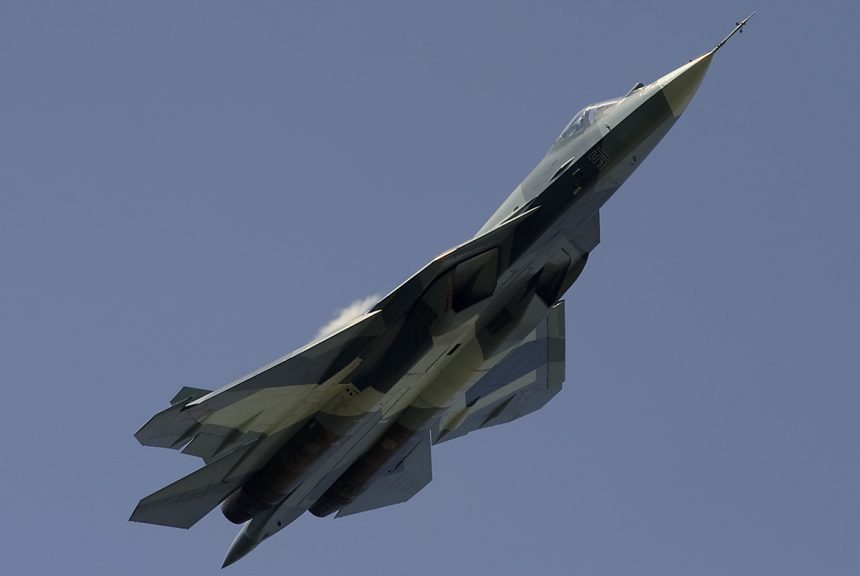Quite surprisingly, Russia sent two of its Su-57 stealth jets to Syria. So, once again, Moscow will use the Syrian Air War as a test bed for its most advanced “hardware”. But the deployment is both an opportunity and a risk.
Late on Feb. 21, a photo showing two Russian Su-57 jets allegedly landing at Khemimim air base, near Latakia, in northwestern Syria, circulated on Twitter. The two stealth combat aircraft were reportedly part of a larger package of assets deployed to the Russian airbase in Syria, that included also four Su-35S and one A-50U AEW (Airborne Early Warning) aircraft.
Didn’t see that coming!!#RuAF deployed today few numbers of their fifth generation fighter jet the Su-57 in #Khmemeim #Syria
Along with
4 Su-35
4 Su-25
1 A-50U pic.twitter.com/2W9ZLPNAOs
— Wael Al Hussaini (@WaelAlHussaini) February 21, 2018
Interestingly, the aircraft appeared to be in “clean” configuration, that is to say they didn’t carry the large fuel tanks used for ferry flights last year.
Although the deployment of two Russian 5th generation aircraft (that has not been officially confirmed yet) came somehow unexpected, it must be noted that it’s not the first time that Moscow deployed some of its advanced “hardware” to Syria. For instance, on Sept. 13, 2017, the Russian Air Force deployed some of its MiG-29SMT multirole combat aircraft to Khemimim airbase for the first time. Previously, in February 2016, it was the turn of the still-in-development Tu-214R spyplane to exploit the air war in Syria to test its sensor packages.
As reported several times commenting the above mentioned deployments, Russia has used the Syrian Air War to showcase and test its latest weapons systems. However, most analysts agree that the deployment of the Su-57 is probably mostly meant to send a strong message about air superiority over Syria, where Russian and American planes have almost clashed quite a few times recently (with conflicting reports of the incidents).
Deploying two new stealth jet in theater is a pretty smart move for diplomatic and marketing purposes: as already explained questions continue to surround the Su-57 program as a consequence of delays, engine problems and subsequent difficult export (last year the Indian Air Force reportedly demanded an end to the joint Indo-Russian stealth fighter project). Albeit rather symbolic, the deployment of a combat aircraft (still under development) is obviously also a huge risk.
First, there’s a risk of being hit (on the ground or during a mission: the attack on Latakia airbase or the recent downing of a Su-25 are just reminders of what may happen over there) and second, there’s a risk of leaking intelligence data to the enemy.
This is what we explained in a recent article about the reasons why U.S. and Russia are shadow-boxing over Syria:
USAF Lt. Col. Pickart’s remarks about the Russians “deliberately testing or baiting us” are indicative of a force managing interactions to collect sensor, intelligence and capability “order of battle”. This intelligence is especially relevant from the current Syrian conflict as it affords both the Russians and the U.S. with the opportunity to operate their latest combat aircraft in close proximity to gauge their real-world sensor capabilities and tactical vulnerabilities, as well as learn doctrine. It is likely the incidents occurring now over Syria, and the intelligence gleaned from them, will be poured over in detail for years to come.
For instance, we have often explained how Raptors act as “electronic warfare enabled sensor-rich multi-role aircraft” over Syria, providing escort to strike packages into and out of the target area while gathering details about the enemy systems and spreading intelligence to other “networked” assets supporting the mission to improve the overall situational awareness. In fact, the F-22 pilot leverage advanced onboard sensors, as the AESA (Active Electronically Scanned Array) radar, to collect valuable details about the enemy, performing ELINT-like missions and then sharing the “picture” with attack planes, command and control assets, as well as Airborne Early Warning aircraft.
In fact, even though it’s safe to assume that the stealth prototype will not use their radar and that the Russians will escort the Su-57s with Su-30/35 Flanker derivatives during their trips over Syria in order to prevent the U.S. spyplanes from being able to “characterize” the Su-57’s signature at specific wavelengths as reportedly done by the Russians with the U.S. F-22s, it’s safe to assume the U.S. and NATO will put in place a significant effort to gather any little detail about the performance and operational capabilities of the new Russian stealth jet.
By the way, before you ask, the risk of confrontation with their U.S. stealth counterparts has not been mentioned, since it seems quite unlikely at the moment..
Top image credit: Aleksandr Markin – T-50 (51), CC BY-SA 2.0









